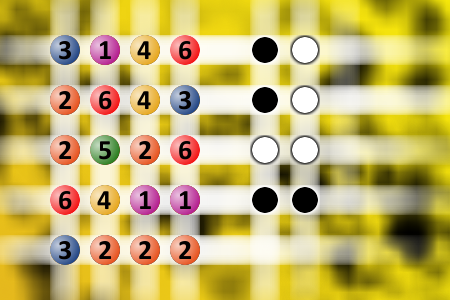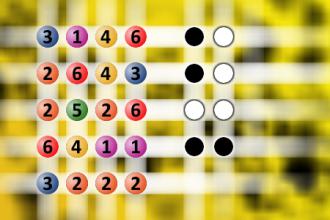Find the right combination
The computer chose a secret code (sequence of 4 digits from 1 to 6). Your goal is to find that code. Black circles indicate the number of hits on the right spot. White circles indicate the number of hits on the wrong spot.Correct answers: 0
#brainteasers #mastermind

A young man wanted to purchase...
A young man wanted to purchase a gift for his new sweetie for Valentine's Day. As they had not been dating very long, it was a very difficult decision. After careful consideration he decided a good gift would be a pair of gloves.
Accompanied by his sister, he went to the store and bought the gloves. His sister purchased a pair of panties at the same time.
The clerk carefully wrapped both items but in the process got them mixed up.
The sister was handed the gloves and the young man got the panties.
The young man mailed his Valentine's Day gift with the following note:
"This special Valentines Day gift was chosen because I noticed you are in the habit of not wearing any when we go out in the evenings.
If it had not been for my sister, I would have chosen the ones with buttons, but she prefers short ones that are much easier to remove.
"These are a lovely shade, the lady I bought them from showed me the pair she had been wearing for the past three weeks and they were hardly soiled. I had her try yours on for me and they looked quite lovely.
I wish I was there to put them on you for the first time; no doubt, other hands will come into contact with them before I have a chance to see you again.
When you take them off, remember to blow on them lightly before putting them away as they will naturally be a little damp from wearing.
Just think how many times I'll be kissing them in the future. I hope you'll wear them Friday night for me.
Love,
Honey Bear
P.S. The sales lady says the latest style is to wear them folded down with just a little fur showing.
Accompanied by his sister, he went to the store and bought the gloves. His sister purchased a pair of panties at the same time.
The clerk carefully wrapped both items but in the process got them mixed up.
The sister was handed the gloves and the young man got the panties.
The young man mailed his Valentine's Day gift with the following note:
"This special Valentines Day gift was chosen because I noticed you are in the habit of not wearing any when we go out in the evenings.
If it had not been for my sister, I would have chosen the ones with buttons, but she prefers short ones that are much easier to remove.
"These are a lovely shade, the lady I bought them from showed me the pair she had been wearing for the past three weeks and they were hardly soiled. I had her try yours on for me and they looked quite lovely.
I wish I was there to put them on you for the first time; no doubt, other hands will come into contact with them before I have a chance to see you again.
When you take them off, remember to blow on them lightly before putting them away as they will naturally be a little damp from wearing.
Just think how many times I'll be kissing them in the future. I hope you'll wear them Friday night for me.
Love,
Honey Bear
P.S. The sales lady says the latest style is to wear them folded down with just a little fur showing.

